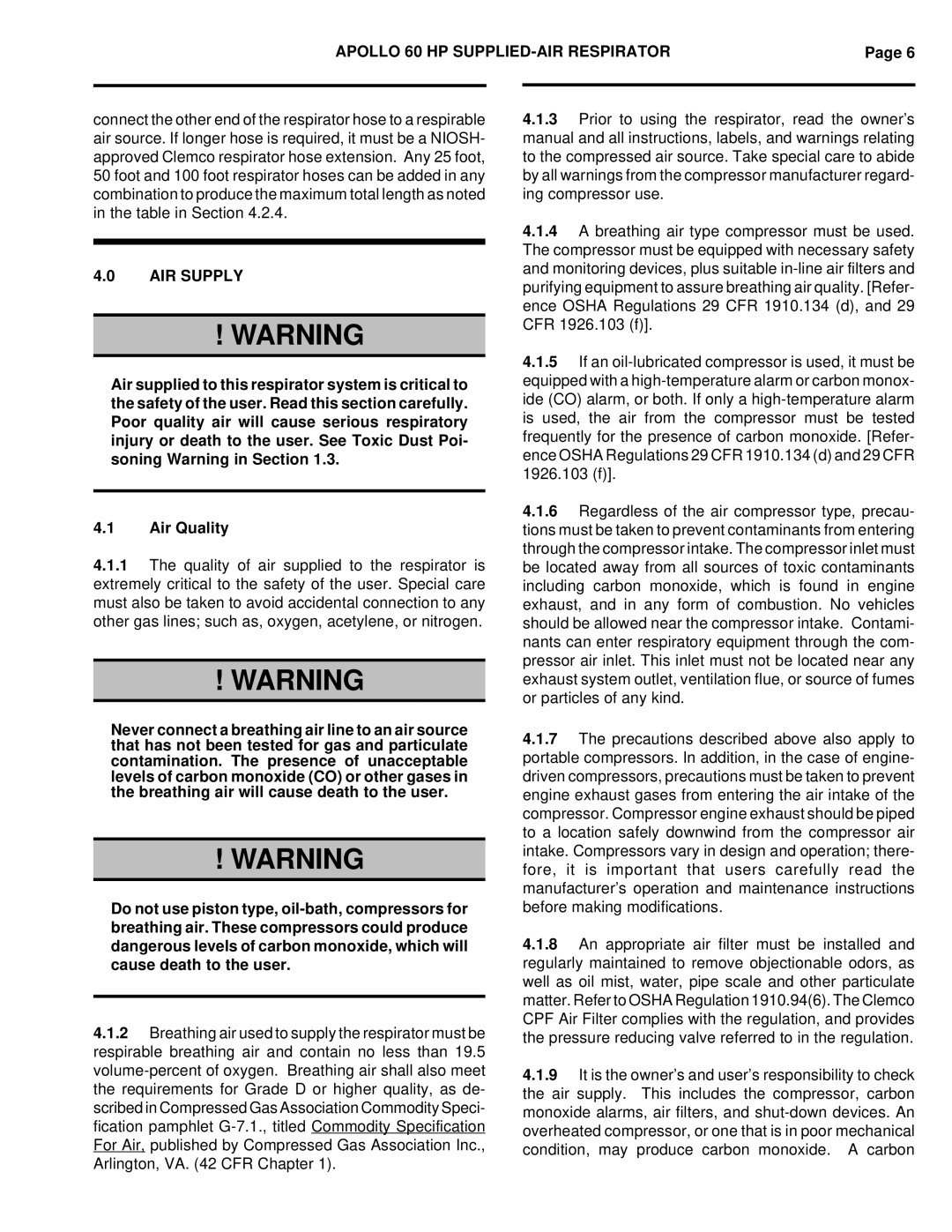
APOLLO 60 HP | Page 6 | ||
|
|
|
|
connect the other end of the respirator hose to a respirable air source. If longer hose is required, it must be a NIOSH- approved Clemco respirator hose extension. Any 25 foot, 50 foot and 100 foot respirator hoses can be added in any combination to produce the maximum total length as noted in the table in Section 4.2.4.
4.0AIR SUPPLY
! WARNING
Air supplied to this respirator system is critical to the safety of the user. Read this section carefully. Poor quality air will cause serious respiratory injury or death to the user. See Toxic Dust Poi- soning Warning in Section 1.3.
4.1Air Quality
4.1.1The quality of air supplied to the respirator is extremely critical to the safety of the user. Special care must also be taken to avoid accidental connection to any other gas lines; such as, oxygen, acetylene, or nitrogen.
! WARNING
Never connect a breathing air line to an air source that has not been tested for gas and particulate contamination. The presence of unacceptable levels of carbon monoxide (CO) or other gases in the breathing air will cause death to the user.
! WARNING
Do not use piston type,
4.1.2Breathing air used to supply the respirator must be respirable breathing air and contain no less than 19.5
4.1.3Prior to using the respirator, read the owner’s manual and all instructions, labels, and warnings relating to the compressed air source. Take special care to abide by all warnings from the compressor manufacturer regard- ing compressor use.
4.1.4A breathing air type compressor must be used. The compressor must be equipped with necessary safety and monitoring devices, plus suitable
4.1.5If an
4.1.6Regardless of the air compressor type, precau- tions must be taken to prevent contaminants from entering through the compressor intake. The compressor inlet must be located away from all sources of toxic contaminants including carbon monoxide, which is found in engine exhaust, and in any form of combustion. No vehicles should be allowed near the compressor intake. Contami- nants can enter respiratory equipment through the com- pressor air inlet. This inlet must not be located near any exhaust system outlet, ventilation flue, or source of fumes or particles of any kind.
4.1.7The precautions described above also apply to portable compressors. In addition, in the case of engine- driven compressors, precautions must be taken to prevent engine exhaust gases from entering the air intake of the compressor. Compressor engine exhaust should be piped to a location safely downwind from the compressor air intake. Compressors vary in design and operation; there- fore, it is important that users carefully read the manufacturer’s operation and maintenance instructions before making modifications.
4.1.8An appropriate air filter must be installed and regularly maintained to remove objectionable odors, as well as oil mist, water, pipe scale and other particulate matter. Refer to OSHA Regulation 1910.94(6). The Clemco CPF Air Filter complies with the regulation, and provides the pressure reducing valve referred to in the regulation.
4.1.9It is the owner’s and user’s responsibility to check the air supply. This includes the compressor, carbon monoxide alarms, air filters, and
